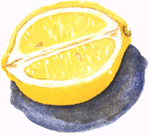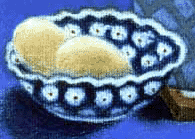Lemon-Glazed Lavender Raisin Buns
From Mollie Katzen's Sunligh Café
Preparation time: 15 to 20 minutes of intermittent work, plus about 2 1/2 hours to rise and bake
Yield: 16 medium-sized buns
Preparation time: 15 to 20 minutes of intermittent work, plus about 2 1/2 hours to rise and bake
Yield: 16 medium-sized buns
 Sweet raisins, an intense
dose of lemon zest, and the otherworldly aromatic presence of
lavender make these buns a great reason to get out of bed in the
morning! The finishing touch is an exquisite lemon glaze, which,
although barely visible, gives a startling punch of additional
flavor.
Sweet raisins, an intense
dose of lemon zest, and the otherworldly aromatic presence of
lavender make these buns a great reason to get out of bed in the
morning! The finishing touch is an exquisite lemon glaze, which,
although barely visible, gives a startling punch of additional
flavor.NOTE: If you can't get lavender, substitute rosemary. You can also use a combination of the two.
These buns freeze really well, and defrost very quickly (for example, while you are commuting). Toasting is unnecessary and may cause the raisins and the glaze to burn. So just toss a frozen bun into a sandwich bag and bring it with you to work. By the time you get there, it will be ready to enjoy, and you will thank yourself profusely.
- Remember to zest the lemons before juicing them.
- For a touch of texture, coarsely chop the lemon zest, rather than grating it. The easiest way to do this is to shave off the outermost peel with a vegetable peeler, then chop the shavings into smaller pieces with a sharp knife.
- You can use fresh or dried lavender (and/or rosemary) leaves. If using fresh, be sure to chop it really small.
Nonstick spray for the pan(s) and the dough
1/2 cup golden raisins
1/4 cup fresh lemon juice
1 recipe Babka Dough (recipe follows)
1 tablespoon unsalted butter, softened
3 tablespoons chopped lemon zest
1 1/2 tablespoons stripped and crumbled lavender leaves (OK to include some blossoms for color)
1/2 cup golden raisins
1/4 cup fresh lemon juice
1 recipe Babka Dough (recipe follows)
1 tablespoon unsalted butter, softened
3 tablespoons chopped lemon zest
1 1/2 tablespoons stripped and crumbled lavender leaves (OK to include some blossoms for color)
LEMON GLAZE
1/2 cup powdered sugar
1 tablespoon fresh lemon juice
1 tablespoon fresh lemon juice
- Lightly spray two 8- or 9-inch round cake pans or a baking tray–plus a clean, dry work surface–with nonstick spray.
- Place the raisins and lemon juice in a small bowl, and heat together in a microwave oven for about 40 seconds. Remove and set aside
- Spray your fist lightly with nonstick spray, punch down the
risen dough, and transfer it to the prepared work surface. Let the
dough rest for about five minutes, then without further handling or
kneading, gently stretch it into a rectangle approximately 10 X 16
inches. If the dough is too sticky to handle, add a little nonstick
spray to your hands. Use a rubber spatula to spread the dough with
softened butter, leaving a 1/2-inch border around the edge
- Sprinkle the buttered area with chopped lemon zest, crumbled lavender, and the plumped raisins. Roll up the dough into a firm log, and pinch the seam tightly closed.
- Cut the log into 16 equal pieces, and place them on end about 2 inches apart in the prepared pans–or on the tray.
- Cover the pans or tray loosely with a clean tea towel, and let stand in a warm place for about 1 hour. The buns will increase in bulk by about 50 to 75 per cent. During this time, preheat the oven to 350F.
- Before baking the buns, push in any exposed raisins with a chopstick. Then place the pans or tray in the center of the preheated oven for 15 to 20 minutes, or until the buns are lightly browned on the edges and sound hollow when thumped. Transfer the hot buns to a plate or a platter; wait 10 minutes before adding the glaze. Prepare the glaze during this time.
- Sift the powdered sugar through a tea strainer into a small bowl and stir in the lemon juice. Drizzle this onto each bun with a small spoon–or brush it on with a pastry brush. It will be thin and subtle–barely visible–but will coat the buns, sinking in slightly. Wait another 10 minutes or so before serving.

BABKA DOUGH
 1/2 cup milk (plain soy
milk will also work)
1/2 cup milk (plain soy
milk will also work)3 tablespoons unsalted butter
1/4 cup wrist-temperature water
1 1/4 teaspoons yeast (half a package)
3 tablespoons sugar
1 large egg
1 1/4 teaspoons salt
About 2 1/3 cups bread flour or unbleached all-purpose flour
(Enough to make a soft dough)
Nonstick spray for the bowl, the work surface, and your hands
- DO THIS AHEAD: Gradually heat the milk in a small saucepan until it becomes very hot but is not yet boiling. Remove the pan from the heat, and add cut in the butter in about 4 or 5 slices. Set aside to cool to wrist temperature, during which time the butter will melt.
- Place the water in a medium-large bowl, sprinkle in the yeast, and let it stand for about 5 minutes.
- When the milk mixture has cooled to wrist temperature (and no warmer!), add it to the yeast, along with the sugar and salt. Beat in the egg.
- Add the flour one cup at a time, beating after the first addition with a large whisk, and after the second with a wooden spoon. At some point you will have to graduate from the spoon to using your hand. Add small amounts of flour to keep your hand from sticking too badly, and m;ix until all the flour is incorporated, and you have a soft dough. It's OK if it's slightly sticky.
- Lightly spray a clean work surface with nonstick spray. Turn out the dough, and knead it just a few times, pushing it into itself, so it comes together in a smooth ball . If it is too sticky to handle, spray the palms of your hands with a little nonstick spray. The goal is to keep the dough as soft as possible–even a little wet!
- Clean out and dry the bowl (or use a second clean, dry bowl) and coat the inside surface with nonstick spray. Place the dough in the bowl, and spray the top surface with more nonstick spray. Cover the bowl with a clean tea towel, and put it in a warm place to rise until doubled in bulk.
- Punch down the dough, and proceed with filling and finishing. (above). You can also refrigerate or freeze the dough at this point, if you don't intend to fill and finish it right away. (Wrap it in a sealed plastic bag.)






